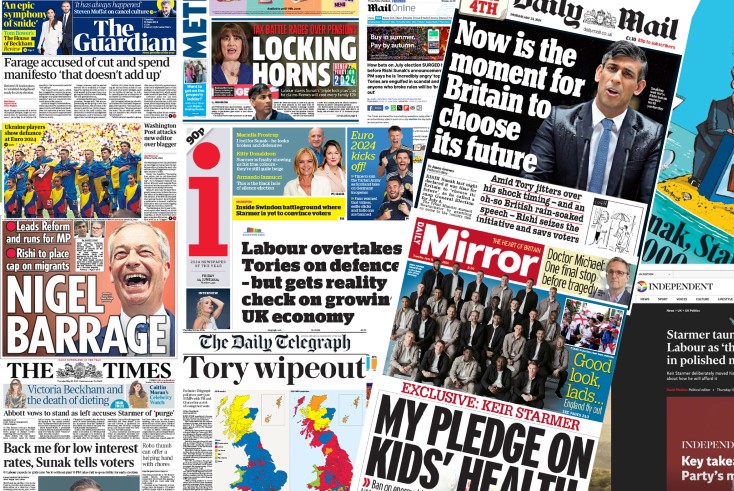Advertising adjacent to quality news content is brand-safe regardless of topic

It is safe for brands to advertise adjacent to quality news content, regardless of topic.
That is the key conclusion from the Future of News UK report conducted by market research company HarrisX, a subsidiary of challenger agency holding group Stagwell.
The study found that ads placed adjacent to stories covering politics or crime performed just as effectively when measuring for purchase intent, favourability and other reputational brand metrics compared with ads placed next to more positive stories relating to business, sports and entertainment.
HarrisX tested six brand ads placed next to eight types of real news content: the Middle East, crime, Nigel Farage, Sir Keir Starmer, inflation, business, sports and entertainment.
The study found there was, overall, less than a three percentage point difference in brand performance across all eight articles tested.
Stagwell CEO Mark Penn told The Media Leader he was surprised at how consistent the results were across all different types of advertising.
“Our thesis proved out correct not only in the US but in the UK as well,” he said. “Ads placed next to politics and crime stories did just as well as those placed next to positive business stories or sports and entertainment stories.”
Penn continued: “What I noticed both at Microsoft and in talking to people in the industry is that many companies, including Microsoft with a large budget, routinely block out the entire news industry, advertising exclusively in sports and entertainment.
“This study shows that that practice doesn’t make sense. You should be diversifying your buy, you should be testing out ads on news sites, and you should understand that the news consumer — people with long attention spans who are consuming information across many products — would be incredible consumers.”
No evidence of brand-safety concerns
Brands were selected for the study from a variety of sectors among the 100 best-known UK companies and varied in corporate reputational strength. Stagwell said the brands themselves had no input in the study.
The same is true of publishers. News stories were selected from Stagwell’s publishing partners, which include World Media Group members, but the study was conducted without their input.
Furthermore, to focus on ad adjacency, the names of publishers were removed from the digital environment in which the research was conducted, meaning survey respondents could not make biased value judgements based on their perception of a given news brand.
Half of Reach’s Euro 2024 coverage wrongly identified by brands as unsafe
HarrisX surveyed 22,116 British adults, with approximately 2,450 selected to provide feedback on advertising per individual news topic. Respondents were asked to assess their purchase intent and brand favourability, among other brand metrics, in relation to the advertising served.
Breaking the study down by demographic, Stagwell found no evidence of brand-safety concerns among respondents who said they follow the news closely, Gen Z, mothers, those with a university degree, high earners, Labour voters, Reform voters and voters of all other parties.
It did, however, find a slight ad adjacency impact among Conservative voters, who reported slightly higher brand favourability for ads adjacent to articles relating to business and sports.
Commenting on the findings, Jamie Credland, CEO of news media alliance World Media Group, told The Media Leader: “The research is pretty clear that there is no real impact on brand performance through supposedly ‘brand-unsafe’ news articles.”
He added: “I would further argue that there are multiple historic studies that have shown having a premium, trusted brand in the masthead actually increases brand perception of the brand’s advertising, but that the content of the article itself (whether [about] Farage, Starmer, inflation or other ‘hard news’ topics) does not make any difference. Consumers understand the difference between the editorial content and the advertising message.”
‘Stick to quality media partners’
The findings are revealed at a time when brands continue to avoid placing ads on articles from trusted news publishers that they worry is brand-unsafe. Current events reporting around politics, crime and war is routinely demonitised by advertisers not wanting their brand associated with negative news.
Indeed, Credland has previously warned that publishers’ biggest challenge in what has been a major year for geopolitical news is “advertisers or marketers who are shying away from election or war coverage, who are perhaps using keyword blocklists in an indiscriminate way and may not even be aware of it”.
Such keyword-blocking practices are often considered by publishers to be irresponsible. In an interview with The Media Leader, Mantis founder and executive vice-president Terry Hornsby explained that advertisers regularly add words to their blocklists without sufficiently checking which words may be worth taking off. These could include “Taylor Swift” in relation to the foiled Vienna concert terror attack earlier this summer.
Meanwhile, other commonly blocklisted words such as “shoot” or “shoots” result in demonitisation of uncontroversial articles relating to, for example, sports. This summer, nearly half of Reach’s Euro 2024 coverage was wrongly identified by brands as unsafe in this way and thus blocked from receiving advertising.
Credland continued: “It is worth remembering that the whole reason the brand-safety industry sprung up was due to controversies on social media, which led to the World Federation of Advertisers starting the Global Alliance for Responsible Media process.
“Specifically, the Christchurch attack in New Zealand and the Isis beheadings, both of which featured on social media platforms with advertising from major brands next to them. This type of content would never be broadcast by news brands with professionally trained journalists in charge of the editorial output.
“The whole brand-safety industry is fundamentally unnecessary if brands stick to quality media partners. This approach would also save brands a significant proportion of their budgets, which are currently diverted to pay for flawed brand-safety technologies.”
How keyword-blocking still harms publishers — with Mantis’ Terry Hornsby




